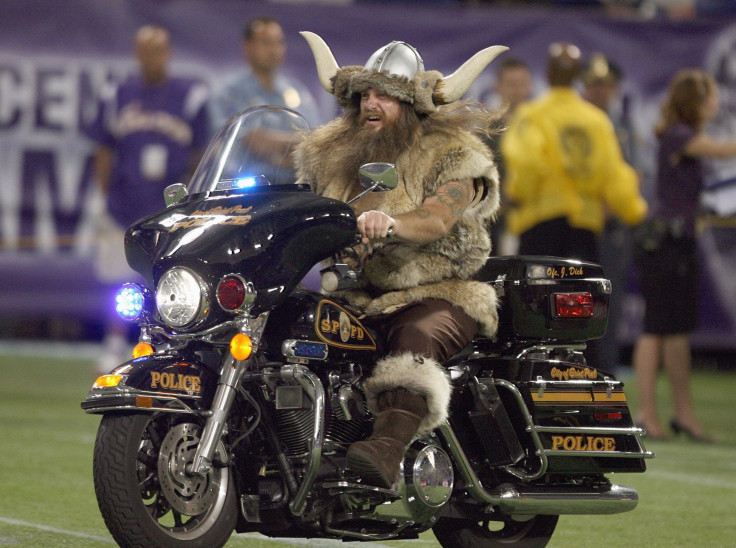How Much Money Do Sports Mascots Make? Unfortunately For Ragnar The Viking, Independent Contractors Earn Less

Minnesota Vikings fans are outraged this week after the franchise broke off negotiations with Ragnar the Viking, its unofficial mascot for the past two decades, due to high salary demands. But industry standards suggest Ragnar’s attempt to pillage the franchise’s coffers was misguided.
Joe Juranitch, the man behind the Vikings’ Ragnar character, sought $20,000 per game over the next 10 years to dress like a real-life Viking and lead the team’s players onto the field on his trademark motorcycle -- a substantial raise from his current salary of $1,500 per game, according to the Associated Press. For the Vikings, who also have a costumed official mascot named Viktor, Ragnar just isn’t valuable enough to justify such a drastic raise.
“You’re not going to pay him $160,000 because you like him and he does a nice job. That’s great, too, but at some point, you gotta say, 'We can’t spend that money for something relatively ancillary,'” said Dave Raymond, the original Phillie Phanatic and founder of Raymond Entertainment, a mascot staffing and consulting firm. “The fans like him, but they’re not revolting and turning in their season tickets because he’s not coming,”
Full-time, costumed team mascots, even those who have just started in the industry, regularly earn a minimum of $50,000 annually, with thousands more in incentive-based earnings, Raymond said. More seasoned performers, like Clutch of the NBA’s Houston Rockets or the Phanatic of MLB’s Philadelphia Phillies, earn six-figure salaries, bolstered through their value as performers, merchandising and advertising. These well-known mascots often serve as brand ambassadors, standing in for team executives and players in commercials and fan events. Salaries can drop off dramatically for independent contractors like Juranitch. That’s particularly true if the freelancer’s value to the franchise and its fan community is considered replaceable.
Juranitch had served as the Vikings’ unofficial team mascot since 1993, when he was selected from among 3,000 applicants. His horned helmet has been a fixture at Vikings home games, where Ragnar has made appearances for the past two decades.
The Vikings declined to comment on whether Juranitch appeared as Ragnar at team functions besides home games or represented the franchise in any capacity away from the field. Team officials thanked Juranitch for his longtime service in a statement this week.
“This offseason, Joe Juranitch’s [Ragnar] contract with the Vikings expired. Since then the team has had multiple conversations with Joe but has not been able to reach an agreement on his role with the team moving forward. The Vikings greatly appreciate what Ragnar has meant to the organization and to the fans over the last two decades. We intend to honor his 21 seasons on the field during a 2015 Vikings home game, and we will welcome him to future ceremonial events. We will always consider Ragnar an important part of Vikings history,” the team’s statement said.
The team’s decision to move on from its association with Ragnar is receiving a negative reaction from Vikings fans, who are taking to the Internet to voice their displeasure. The Facebook post in which Juranitch announced his absence from Vikings games received nearly 900 “likes” as of Tuesday morning. A Change.org petition asking to “Reinstate Ragnar” amassed nearly 10,000 signatures.
Most professional sports franchises in America’s four major sports employ some form of an official mascot. Raymond’s firm has worked with several professional sports teams, including the MLB’s Phillies, the Cincinnati Reds, the NFL’s Philadelphia Eagles and Manchester City FC of the English Premier League. He estimates “close to 100 percent” of NBA teams have a full-time mascot, and said the league’s mascots are among the highest-paid in the country. Roughly half of all teams in the MLB, NFL and NHL employ a full-time official mascot.
A mascot’s value lies entirely in his ability to drive fan engagement and brand appeal, Raymond said. Salaries are dictated by whether a franchise feels it can receive a return on its investment -- through merchandise sales, advertising and fan goodwill -- at roughly two to four times a performance’s annual wages. It’s up to the team to tabulate those benefits as a dollar amount.
For a performer like Juranitch -- a longtime franchise employee but one who lacks a costume or a full-time deal, a request of about $5,000 per game would have been more realistic, Raymond added. Juranitch’s $20,000-per-game demand would have paid $2 million over 10 years, counting preseason games.
“If all he’s doing is appearing at games, frankly, you could find a good actor and develop your own human Viking costume and get somebody to do an outstanding job and still get value from a fan standpoint,” Raymond said.
© Copyright IBTimes 2024. All rights reserved.






















